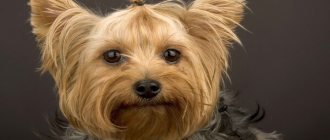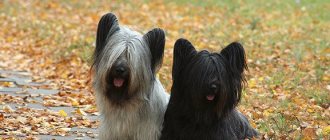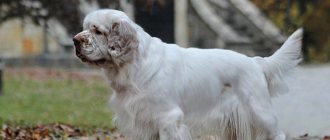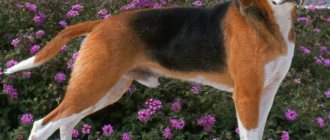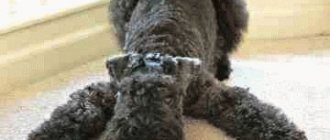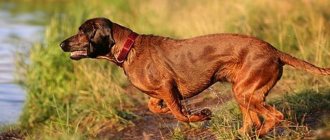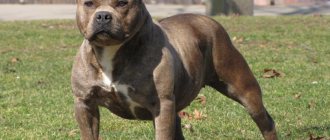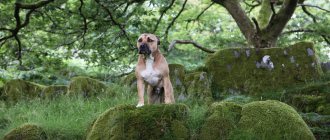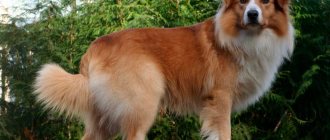Main characteristics
| Breed parameters | |
| Country of origin: | England |
| Weight of the breed: | males: 6-7 kg, females: 5-6 kg |
| Height at withers: | males: 33-40 cm, females: 28-36 cm |
| Temperament: | active |
| Wool: | short |
| Role in human life: | companion, hunting, guard |
It is difficult to find another breed that would be distinguished by such irrepressible character and energy. They are constantly on the move and almost never get tired. They are ready to give of themselves 24 hours a day.
Fox terrier
Two versions of Fox Terriers are regulated. Species names : smooth-haired and wire-haired terrier The International Cynology Union FCI classifies dogs as large and medium terriers. The ideal weight is 8.2 kg.
The dogs are well built. The head is elongated, with rectangular contours. The long neck holds the head in a proud, defiant position. The body is rectangular, the length of the body is 2.5 times the height. The limbs are high, the front ones stand straight, the hind limbs are slightly laid back, emphasizing the readiness to move.
Cocky fox terriers are quite common. Their current main occupation is keeping people company. The main requirements that dogs make of their owners are maximum movement and attentive care. Wire-haired dogs require hand plucking, which is done twice a year.
History of the breed
The Border Terrier breed was bred specifically to fight foxes, which plagued farms in the 18th century. In addition to protecting farmlands, the border dog was excellent at hunting pests, thus bringing valuable fur to local residents.
One of the earliest evidence of the existence of these animals is a painting by A. Wentworth from 1754, which depicts two border terriers. At that time, throughout almost the entire territory of England, these dogs were highly valued and were successfully used both for protection and for hunting. At the same time, practically nothing was known about them outside the country.
Only by the end of the 20s was the breed recognized by the English Kennel Club and they went beyond the territory of the country. But unfortunately, even after recognition, the breed remained not particularly in demand and popular. Even after a quarter of a century, these small hunters remain little known.
They are known most of all in their historical homeland and the United States, much less in Europe and the CIS. However, low popularity has a positive effect on the purity of the breed and its basic characteristics. Terriers have not changed much since their inception and remain truly magnificent pets for cheerful and energetic people.
Advantages and disadvantages
The breed has good service and working characteristics. Borders are cheerful, active and not too noisy pets. They only bark when they give a hunting signal. Open and good-natured, they get along well with people and willingly spend time with children.
One of the disadvantages is their ineradicable instinct to dig, so that without supervision the pet can dig up the entire area. Borders love to chew on something, so they cannot do without special devices. People with a sedentary lifestyle should not get a Border Terrier , as an active animal will suffer without physical activity. Borders experience severe stress even when their owner is absent for a long time.
Some people think that the Border Terrier is a nondescript dog, and dog handlers are still arguing about the incomplete appearance of the breed. There is still some debate about separating Border Terriers for show into varieties based on size and weight. Some consider the correct size to be the most important aspect of border dog conformation. What do you think?
a brief description of
The Border Terrier is a kind and affectionate creature that will always be there and come to the rescue in difficult times. He will support you in difficult times and will be with you in sorrow and joy. However, for all its gentleness, it is a merciless hunter, distinguished by speed, agility and swiftness.
The dog is very active, cheerful, and temperamental. Border loves fun games in nature, he is interested in new smells, rustles, other animals and new places. If you live in a private house, then he will happily explore the world around him. In addition, the terrier will be happy to accompany you on a hike, run a marathon and go traveling. This is an excellent partner for a morning jog and a constant companion for children in their dirty tricks.
Character
To briefly describe the Border Terrier, it is a fearless, very energetic, ruthless dog when hunting, but a friendly, one might say, affectionate dog at home.
Border is not a decorative, sofa pet. He has a balanced character, is not picky and friendly. The terrier is always ready for active games and fun, but often plays pranks and loves to play pranks.
The Border Terrier is very inquisitive. He takes every opportunity to explore the world around him. He is literally interested in everything - sounds, smells, new places, people, animals, birds...
It is curiosity that pushes the terrier to run away, to uncontrolled independent walks.
Representatives of the breed get along well with children, especially teenagers. Border plays with pleasure and tolerates children's pranks quite patiently.
But there are limits to this patience, so there is no need to leave the terrier alone with small children. It is important to teach your child to treat the dog with respect and care.
Border is endlessly friendly. He never shows causeless aggression. Can make friends with people close to the family, enjoys the arrival of guests and peacefully watches strangers on the street.
But if a stranger enters the terrier’s territory without asking, the dog will immediately notify the owner of the uninvited guests with a loud bark.
It gets along well with other pets, but it is not recommended to keep a born rat-catcher together with decorative rodents. He is able to make friends with a cat if he grew up with her in the same house. He is very friendly with other dogs, as he has a pack instinct.
Breed standard
These animals belong to the small breeds of the terrier group. Their maximum weight is about 7 kg, and their height is no more than 40 cm. The body is harmonious, small in size, and the chest is well developed. The legs are straight, muscular and strong. The tail is short and set high.
The head is in proportion to the body, elongated, the muzzle is blunt. The eyes are medium, sharp, penetrating gaze. The color is almost black. The ears are triangular in shape, folded forward and tilted forward.
The coat is thick, hard to the touch, lying close to the body. Well protects the animal in bad weather conditions. Acceptable colors: blue and tan, wheaten, red, gray and tan (grizzly color).
Health and life expectancy
Border terriers are among the prosperous breeds. These small, strong dogs have good health and immunity, and on average live 13-15 years. First of all, this is a merit of competent breeding and careful selection of dogs for health. Naturally, there are no absolutely healthy breeds, it is rare, but hereditary diseases occur in borders:
- Joint dysplasia (elbow or hip, most often in a mild form);
- Heart defects;
- Epileptoid convulsive syndrome;
- Ataxia of newborns;
- Allergy;
- Cryptorchidism;
- Anomalies of the dental formula (overbite, oligodontia);
- bobtail;
- Epilepsy;
- Eye diseases (progressive retinal atrophy, cataracts);
- Perthes disease.
It is important that your veterinarian be made aware that Border Terriers often exhibit a slow response to anesthesia.
Good health of Border Terriers does not mean that owners can ignore preventative care. Dogs must be vaccinated according to established schedules. Treatments for external and internal parasites are regularly carried out, the frequency of which depends on the means used. Living conditions, balanced nutrition and care are important in maintaining health. It is advisable to undergo a routine medical examination annually.
Education and training
Animals of this breed group are distinguished by their intelligence and intelligence. They quickly learn new commands, love to demonstrate what they have learned, and appreciate well-deserved praise. Unlike others, these animals remain playful and cheerful for a long time. This point must be taken into account during training. Sometimes, to achieve high results it is necessary to resort to tactical games.
By playing, your pet will quickly remember what he is taught. Good-natured dogs do not accept rude treatment, much less assault. You cannot shout at them and throw out accumulated negativity on them. They are very sensitive and know how to take offense. They respond more quickly to affectionate treatment and encouragement.
Young animals are sometimes frightened by noise, so they need to be gradually accustomed to the noise of the city, television and traffic. They have a bright mind and a good memory, in addition, they like to serve their person, they do it with pleasure. Experienced dog breeders recommend that beginners enlist the support of an experienced dog handler during the training period.
To get the most out of it, you need to spend a lot of time with the animal. Only by achieving an emotional connection will you receive a loyal and reliable friend. This can be done by paying maximum attention to it, because training alone is not enough. If you want to go on long walks with your pet, go out into nature, take it with you on trips.
Japanese Terrier
A rare dog even in Japan, its homeland. The dog is small in size, its average parameters are: 30 cm height and 3 kg weight. A very elegant warehouse. The short, 2-millimeter coat clings to the body, creating the impression of a velvet cover.
Breeding of the breed began in 1900. Japanese breeders did not intend to create a hunting breed. They made a wonderful companion. The breed was officially recognized in 1964. Despite all the advantages, Japanese terriers have not become widespread.
Care and maintenance
Dogs are not particularly picky about grooming. They adapt well to any conditions and feel great both in a private home and in a small apartment. The main thing is to arrange their own corner and provide them with a bowl for food and water, as well as a few toys to distract their attention from the interior items.
Since they are a hunting breed, they need constant physical activity, therefore, you will have to walk such a pet often and for a long time. You will also have to organize forays into nature so that the dog can splash out all its energy reserves.
The animal will have to be combed daily and trimmed a couple of times a year. You should bathe when dirty. Ears and eyes require special care, especially in the spring and summer. Claws are trimmed as they grow. It is advisable to brush your teeth every week using a special toothpaste and brush.
To avoid problems with your pet’s health, it is necessary to regularly show it to a veterinarian, get vaccinated and treated for parasites.
Features of feeding and diet
The Border Terrier does not need specialized food, nor does it need fancy food. However, from a young age, the puppy is taught to eat healthy food. As an adult, the dog can be fed both dry food and raw meat.
Up to 1.5 years, a dog’s diet should consist of:
- boiled meat (beef or lamb);
- low-fat fermented milk products, cottage cheese;
- once a week you should give a boiled egg;
- buckwheat and millet.
These products contribute not only to the full saturation of the baby, but also to strengthen his bones, muscles and ligaments, which allows him to grow strong, healthy and cheerful.
You need to carefully monitor your Border Terrier's diet. These dogs love to overeat, as a result of which they quickly gain weight. It is important to regulate the portion size regardless of whether the dog is fed dry food or homemade food.
Feed your dog 3-4 times a day in small portions. This will prevent the small stomach from stretching and the dog will not feel hungry. When it's time to switch your dog to dry food, grind it up and soak it in water or milk for the first few weeks. Introduce any supplements into your diet only as directed by your veterinarian.
Nutrition
The diet for the Border Terrier must be prepared very carefully, as these animals are prone to allergic reactions. An allergy can be caused by any unfamiliar product. Therefore, each new ingredient is selected very carefully and given in small quantities for a certain period.
Products that can trigger allergies:
- Eggs (except quail).
- Wheat products.
- Some varieties of fish.
- Industrial feed.
- Dairy products.
- Beef.
- Sweets.
- Corn.
- Legumes.
- Spices.
- Chicken.
Reviews about the breed from the owners
Anatoly (Valdai). Interesting breed. Ideal for anyone who leads an active lifestyle. I often go fishing, I like to wander through the forest... Before the border I had an Airedale and a German. Border, in my opinion, is an excellent travel companion.
Igor (Ekaterinburg). I'm a hunter. Anger at the beast is in the blood of this breed. Brave, tireless, strong. The only side effect is that at home it is a real energizer. He constantly needs movement. Of course, it won’t destroy the apartment, but it can cause damage.
Alina (Moscow). In our family, the Border Terrier plays the role of a pet. And, it’s worth saying, he plays wonderfully. It’s hard to imagine a more affectionate and sociable dog. With his help, I finally pulled my son away from the computer.
We invite you to watch a video in which the owner of border terriers shares her impressions of this breed.
How to choose the right puppy?
The puppy should be adopted no earlier than two months. As a rule, at this age, babies already have documents and have received their first vaccination, with which they can travel to a new home. Up to six months, Border puppies are somewhat darker in color than adults, that is, as they grow older, the puppies become lighter. You need to be prepared for this if color is of paramount importance.
It is advisable to purchase a four-legged friend from a professional nursery, and not from a bird market or from a photo. Get good recommendations, visit the nursery, see the conditions in which the animals live, evaluate the physical characteristics of the parents and look at their exhibition diplomas and documents of origin.
If an animal is purchased for exhibitions and breeding, be sure to check the bite, tail, body balance and general condition. A healthy puppy should be active, inquisitive and playful. The baby should not be lethargic, with streaming eyes and dull fur.
Choosing a Border Terrier Puppy
A competent approach to choosing a purebred dog puppy means that first of all you need to decide on a kennel or breeder. The population of border terriers in Russia and neighboring countries is very small, so lovers of the breed know most of the dogs by name, and the owners communicate closely with each other on thematic forums. By contacting their team, you can get a lot of recommendations on selection, cultivation, care and other issues.
When it comes time to pick up your puppy, it is important to make sure that the baby is over 8 weeks old. All the time from birth, he was close to his mother and brothers, ate well, was treated for external and internal parasites, and had the opportunity to walk to his heart's content. Externally, he should be healthy and well-fed. Temperament is no less important; the puppy should not show cowardice or aggression towards strangers. His main qualities at the age of 2-3 months: curiosity and friendliness.
A purebred puppy has a metric and a brand, the number of which corresponds to the one entered in the “puppy”. The baby must be vaccinated according to age. The proof is the vaccine stickers in the veterinary passport. The issue of microchipping is individual; it matters only if the dog will be exported abroad.
Price
The price of a purebred Border Terrier puppy usually ranges from 35,000-50,000 rubles. The breed is not commercial, so advertisements for the sale of puppies without documents are rare.
